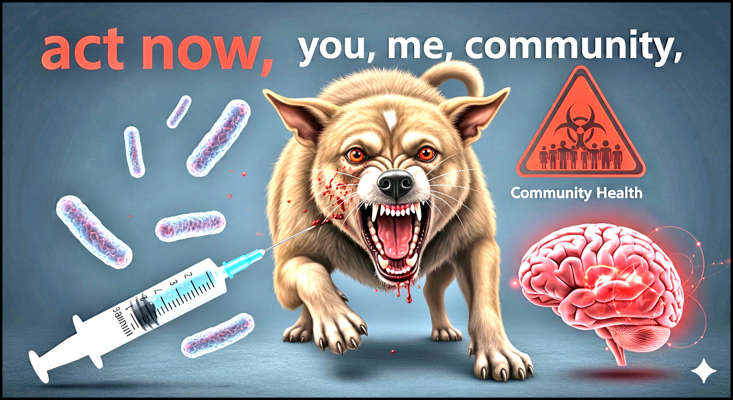
R.K. Bhardwaj & Divyansh Pandey
Every year on September 28, the world observes World Rabies Day to raise awareness and promote prevention and control measures against rabies. World Rabies Day is a United Nations observance and has been endorsed by key UN agencies and other international health organizations. The day honors the death anniversary of Louis Pasteur, who developed the first effective anti-rabies vaccine. The 2025 theme, “Act Now: You, Me & Community,” is a call to action, emphasizing that rabies elimination is a shared responsibility that requires the collaboration of individuals, communities, and health sectors.
Rabies is a deadly yet entirely preventable viral disease caused by the Lyssa virus. It affects all warm-blooded animals and is primarily transmitted through the saliva of an infected animal, most often via a bite or scratch. The incubation period can range from days to years. Early symptoms may include fever and tingling at the bite site, followed by more severe signs like violent movements, hydrophobia (fear of water), paralysis, and eventually, death. Once clinical symptoms appear, the disease is almost always fatal.
The Burden of Rabies in India
Rabies continues to be a significant public health problem in India, which accounts for 36% of global rabies deaths. In 2022, 307 people died from rabies in India, with the highest number of cases reported in Delhi (48 deaths), followed by West Bengal (38), Maharashtra (29), Karnataka (29), and Andhra Pradesh (29). The actual number of deaths may be even higher due to underreporting.
The country’s large stray dog population is the primary reason for this high incidence, with dog bites accounting for up to 96% of rabies infections and deaths in India. The annual number of dog bites is estimated to be 1.7 crore, and in 2024, there were over 2.2 million dog bite cases reported. The stray dog population in India is estimated to be between 30 and 40 million, and they are responsible for 97% of human rabies cases. A recent trend shows a 70% increase in animal bite cases from 2022 to 2024, with Noida and Ludhiana experiencing significant jumps. Children are particularly vulnerable, making up 40% of people exposed to dog bites in endemic areas.
The One Health Approach: A Path to Elimination
The 2025 theme “Act Now: You, Me & Community” is deeply rooted in the “One Health” principle, which recognizes the interdependence of human, animal, and environmental health. This approach is crucial for controlling rabies and other diseases like COVID-19 and antimicrobial resistance.
The National Action Plan for Dog-Mediated Rabies Elimination from India by 2030 (NAPRE) is a multi-pronged strategy based on this “One Health” approach. The plan has a clear vision: to achieve zero human deaths from dog-mediated rabies by 2030. The program has two core components: a human health component and an animal health component.
4Human Health Component: This focuses on preventing human deaths by ensuring timely access to post-exposure prophylaxis (PEP) for all animal bite victims.
4Animal Health Component: This includes mass dog vaccination, aiming to achieve at least 70% vaccination coverage among dogs in a defined area for three consecutive years.
The success of a data-driven rabies elimination program in Goa between 2013 and 2019 serves as a powerful model. It resulted in the elimination of human rabies and a 92% reduction in canine rabies cases. This was achieved through systematic vaccination of over 95,000 dogs and educating 150,000 children annually, demonstrating that human rabies elimination is achievable at the state level in India.
The Role of Technology and Community
To “Act Now” as a community, effective data collection is essential. The success of NAPRE depends on having quality data on both canine and human rabies cases, which is currently sparse and collected by different entities with incomplete methods. A user-friendly, cross-platform smart data collection system is needed to help healthcare workers accurately and swiftly enter data.
In a positive development, the Delhi government has announced a plan to microchip 10 lakh street dogs over two years to strengthen rabies control and dog population management. This initiative, along with a new dog census, aims to provide accurate data and digitize vaccination records. Ghaziabad is also rolling out a similar plan, becoming the first city in Uttar Pradesh to adopt large-scale microchipping of strays to track vaccination and sterilization records. These efforts are in line with the Supreme Court’s directive for states to create policies on street dogs that prioritize sterilization and immunization over confinement.
Mass vaccination of dogs is the most effective solution, as vaccinating 70% of the dog population in endemic areas creates an immune barrier that prevents the disease from spreading. This is also a highly cost-effective measure, as the cost of vaccinating dogs is minimal compared to the expense of emergency post-exposure treatments for bitten individuals. According to the World Organization for Animal Health (OIE), just 10% of the cost of these treatments would be enough to significantly reduce or even eliminate canine rabies.
What We Can Do
The theme “You, Me & Community” underscores the role of every individual.
4Vaccinate your pets on a regular basis.
4Support animal birth control programs (spaying and neutering) to control the stray dog population.
4Educate people in your community about rabies prevention and what to do in case of an animal bite.
4In case of a bite or scratch, immediately wash the wound with soap and water for 10-15 minutes and clean it with a 70% alcohol solution or povidone iodine.
4Seek immediate medical attention and begin post-bite anti-rabies vaccination as soon as possible.
By working together, we can save lives and move closer to the global strategic goal of eliminating human deaths from dog-mediated rabies by 2030.
(The Authors R.K Bhardwaj is Professor (Veterinary Medicine and B.V.Sc & A.H) and Divyansh Pandey is student of F.V.SC & A.H R S Pura of SKUAST-Jammu)

